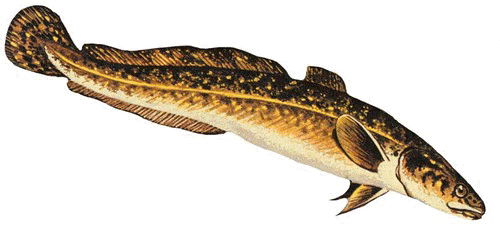The burbot (Lota lota) is often maligned as being too ugly to be worth an angler's time; however, hidden by its mottled green camouflage is a valuable food and recreational fish. The burbot is the only representative of the cod (Gadidae) family in fresh water in North America, and like its saltwater relatives, has mild-tasting white flesh.
Burbot are distributed in fresh waters throughout North America, Europe and Asia with their range extending southward to about 40 degrees north latitude. They occupy most large clear and glacial rivers and many lakes throughout Alaska.
Burbot are known by a number of different names including lawyer, loche, eelpout, methy, lush, lingcod, and mudshark.
The burbot has a thin, elongated body that tapers to a point near the tail. Its major distinguishing characteristics are a barbel or "chin whisker", and dorsal and anal fins that run from the middle of the body almost to the tail. The tail is rounded rather than fork shaped. The mouth is quite large and contains numerous rows of small teeth that slant back toward the throat. Burbot have mottled olive-black or brown skin interspersed with yellow patches. Burbot appear to be scaleless but actually have small, almost microscopic scales.
Burbot are a relatively long-lived and slow-growing species. In Alaska, burbot older than 20 years are not uncommon. It typically takes burbot from five to seven years to reach 18 inches in length. This is also the length at which most Alaska burbot spawn for the first time.
Spawning starts under the ice in December and ends in mid-April. Interior populations aren’t mature until about the age of seven, while more southern populations are capable between two and four years old. Spawning sites are usually shallow and are have stone or gravel bottoms. Breeding takes place at night and starts when a group of burbot (up to a dozen) meet and group closely together. The females that are ready to release eggs, and the males that are ready to fertilize them, press toward the middle of the crowd. The eggs will rest on the bottom until hatching between 30 and 71 days later (depending on water temperature; the colder, the slower).
Newly hatched burbot are only about .3 centimeters long, are colorless, transparent and without a yolk sac. They are unrecognizable as a burbot until they are 1 centimeter long, at which time they will have developed their fins and trademark chin barbel. Many populations will reach this length by early summer. Typically, burbot living in the northern-half of the state will grow slower and live longer than those in southern regions. By the age of 10 the average burbot will be about 24 inches in length. Most individuals do not live beyond the age of 15, at which time they average 28 inches. On an exciting angling note, biologists have observed burbot in Alaska as large as 74 pounds. Young burbot feed mainly on insects and other invertebrates. By the age of five or six, burbot begin to feed almost exclusively on fish. Adult burbot can appear sluggish, but they are voracious predators, feeding mostly at night. Once a burbot has captured a fish, it is reluctant to give it up. Its large mouth, strong jaw, and large number of inward slanting teeth account for the burbot’s efficiency as a predator. Whitefish, sculpins, lampreys, and other burbot are common food items. Burbot will also sometimes eat mice or shrews.
Burbot can be caught in the summer as well as through the ice in the winter. In some areas set-lines or "trot-lines" are used. Individual set-line hooks must have a gap of greater than three-quarters of an inch and be set on the bottom. Set-lines must be inspected every 24 hours and identified with the angler's name and address. Seasons for the set-line use and maximum allowable number of hooks vary between areas, so check your regulations. Burbot can also be caught using standard bait fishing techniques with a fishing pole. A 2/0 or 4/0 single hook baited with a chunk of fresh or frozen fish (herring or whitefish work well) and a sinker located 18 to 24 inches above the hook is a good setup. Cast the bait out and allow the weight to rest on the bottom. In a river the bait will move around near the bottom in the current. When a consistent tug is felt, reel in your catch.
Most fishers like to keep only burbot larger than 18 inches. The best way to release any fish that has swallowed the hook is to just cut the line. The most popular fishing areas in Interior Alaska are large, glacial rivers such as the Yukon and Tanana rivers. Some of the best fishing occurs near rocky bluffs, in back eddies, and near the mouths of clear tributary streams. Burbot are also found in many lakes of Interior and Southcentral Alaska.
|









